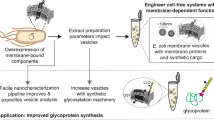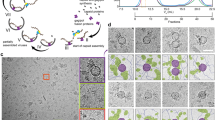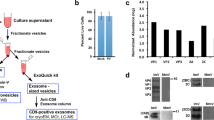Abstract
We have used a pure lytic glucanase enzyme to selectively release recombinant 60 nm protein particles (virus like particles or VLPs) from yeast cells. Although the protease components of the lytic enzyme complexes were found to degrade the VLPs, purified glucanase enzymes from these complexes (derived from Cytophaga sp. and Oerskovia sp.) produced cell lysis without degradation and released the VLPs in the absence of mercaptoethanol, a reducing agent commonly used in cell lysis. The Oerskovia glucanase enzyme released the recombinant protein particles selectively as it only produced ca. 17% cell lysis compared to the use of the total lytic enzyme preparation. The use of osmotic supports did not improve the recovery of VLPs, however, treatment of the enzymatically lysed pellet with Triton X-100 did increase the amount of VLPs released. This ‘selectivity’, which results in the release of the recombinant particles with only a fraction of contaminating proteins, represents an improvement over presently used mechanical or enzymatic cell disruption processes.
This is a preview of subscription content, access via your institution
Access options
Subscribe to this journal
Receive 12 print issues and online access
$209.00 per year
only $17.42 per issue
Buy this article
- Purchase on Springer Link
- Instant access to full article PDF
Prices may be subject to local taxes which are calculated during checkout
Similar content being viewed by others
References
Andrews, B.A., Huang, R.-B. and Asenjo, J.A. 1990. Differential product release from yeast cells by selective enzymatic lysis. 21–28. In: Separations for Biotechnology 2.Pyle, D. L. (Ed.). Elsevier Applied Science, Cambridge, UK.
Huang, R.-B., Andrews, B.A. and Asenjo, J.A. 1991. Differentia] product release from yeast: A new technique for selective product recovery from microbial cells. Biotechnol. Bioeng. 38: 977–985.
Cameron, J.R., Loh, E.Y. and Davis, R.W. 1979. Evidence for transposition of dispersed repetitive DNA families in yeast. Cell 16: 739–751.
Garfinkel, D.J., Boeke, J.D. and Fink, G.R. 1985. Ty element transposition: Reverse transcriptase and virus-like particles. Cell 42: 507–517.
Kingsman, S.M. and Kingsman, A.J. 1988. Polyvalent recombinant antigens: A new vaccine strategy. Vaccine 7: 304–306.
Boeke, J.D., Garfinkel, D.J., Styles, C.A. and Fink, G.R. 1985. Ty elements transpose through an RNA intermediate. Cell 70: 491–500.
Adams, S.E., Kingsman, S.M. and Kingsman, A.J. 1987. The yeast Ty element: Recent advances in the study of a model retro-element. Bioessays 7: 3–9.
Asenjo, J.A., Andrews, B.A. and Pitts, J.M. 1988. Design of enzyme systems for selective product release from microbial cells; isolation of a recombinant protein from yeast. Ann. N.Y. Acad. Sci. 52: 140–152.
Huang, R.-B. 1990. Selective separation of yeast proteins by differential product release, enzymatic lysis and aqueous two-phase systems. Ph.D. Thesis, University of Reading, UK.
Ventom, A.M. and Asenjo, J.A. 1990. Purification of the major glucanase of Oerskovia xanthineolytica LL-GI09. Biotechnol. Techniques 4: 165–170.
Ventom, A.M. and Asenjo, J.A. 1990. Two extracellular proteases from Oerskovia xanthineolyticaLL-G109. Biotechnol. Techniques 4: 171–176.
Ventom, A.M. and Asenjo, J.A. 1991. Characterization of yeast lytic enzymes from Oerskovia xanthineolyticaLL-G109. Enzyme Microb. Technol. 13: 71–75.
Andrews, B.A. and Asenjo, J.A. 1987. Enzymatic lysis and disruption of microbial cells. Trends in Biotechnol. 5: 273–277.
Varela, O. 1991. Maximization of enzyme (glucanase) production using optimized fed-batch cultures. M.Sc. Dissertation, University of Reading-Universidad Autonoma de Barcelona (ERASMUS programme).
Shen, S.H., Chretien, P., Bastien, L. and Slilaty, S.N. 1991. Primary sequence of the glucanase gene from Oerskovia xanthineolytica. J. Biol. Chem. 266: 1058–1063.
Andrews, B.A. and Asenjo, J.A. 1986. Synthesis and regulation of extracellular β(1–3) glucanase and protease by Cytophaga sp. in batch and continuous culture. Biotechnol. Bioeng. 28: 1366–1375.
Andrews, B.A. and Asenjo, J.A. 1987. Continuous culture studies of synthesis and regulation of extracellular β(1–3) glucanase and protease enzymes from Oerskovia xanthineolytica. Biotechnol. Bioeng. 30: 628–637.
Towbin, H., Staehelin, T. and Gordon, J. 1979. Electrophoretic transfer of proteins from polyacrylamide gels to nitrocellulose sheets: Procedure and some applications. Proc. Natl. Acad. Sci. USA 76: 4350–4354.
Hawkes, R. 1987. The dot immunobinding assay. Methods in Enzymol. 121: 484–491.
Author information
Authors and Affiliations
Rights and permissions
About this article
Cite this article
Asenjo, J., Ventom, A., Huang, RB. et al. Selective Release of Recombinant Protein Particles (VLPs) from Yeast Using a Pure Lytic Glucanase Enzyme. Nat Biotechnol 11, 214–217 (1993). https://doi.org/10.1038/nbt0293-214
Received:
Accepted:
Issue Date:
DOI: https://doi.org/10.1038/nbt0293-214
This article is cited by
-
Selective extraction of recombinant membrane proteins from Hansenula polymorpha by pulsed electric field and lytic enzyme pretreatment
Microbial Cell Factories (2023)
-
Development of conditional cell lysis mutants of Saccharomyces cerevisiae as production hosts by modulating OCH1 and CHS3 expression
Applied Microbiology and Biotechnology (2019)
-
Electroinduced Extraction of Human Ferritin Heavy Chain Expressed in Hansenula polymorpha
Applied Biochemistry and Biotechnology (2018)
-
Evidence that Pulsed Electric Field Treatment Enhances the Cell Wall Porosity of Yeast Cells
Applied Biochemistry and Biotechnology (2014)
-
Enzymatic lysis of microbial cells
Biotechnology Letters (2007)



